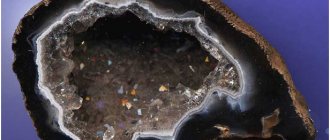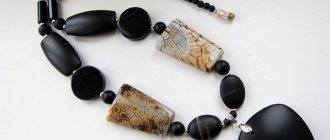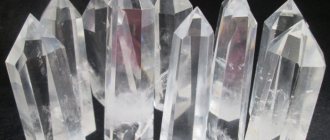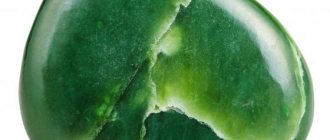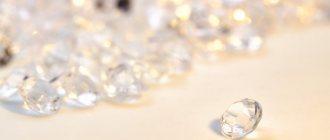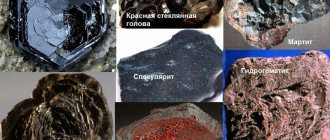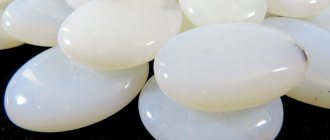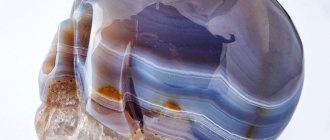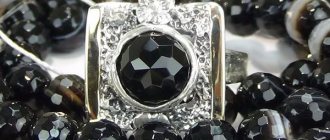| Category | Oxides (minerals) |
| Title in English | Agate |
| Formula | SiO2 |
| Group | Mineral, silica |
| Color | White, Grey, Blue, Yellow, Red, Black |
| Stroke color | White |
| Shine | Matte, Dull |
| Transparency | Translucent |
| singonia | Trigonal |
| Hardness | 6,5 — 7 |
| Cleavage | Missing |
| Density, g/cm³ | 2.6 g/cm³ |
| Kink | Rough, Conchoidal |
| origin of name | There are two options for the origin of the name Agate stone. According to the ancient Roman writer Pliny the Elder, the name of the jewelry and ornamental stone comes from the Achates River, which flows on the island of Sicily. Since those ancient years, the rivers have managed to change their names and there is an assumption that these are the Karabi or Dirillo rivers. According to the second version, the name of the stone comes from the Greek word “ἀγαθός”, which is translated into Russian as kind, good and happy. |
| Morphology | Agate is a dense chalcedony formation that contains inclusions of quartz, quartz and mechanical impurities such as goethite, hematite, celadonite, chlorite and others. |
Story
The word "agate" is attributed to the Achates River, which is located in Sicily and where the oldest developed deposit of the mineral was discovered.
Another explanation comes from the Greek word “ἀγαθός”, which translates as kindness, happiness.
— Advertising —
Since the agate pattern is similar to an eye, there is a legend that it is the eye of a white eagle that fell to Earth in a battle with a black magician and turned into stone. And the bird's eye still looks at people, and divides good and evil deeds. Sometimes agate is called the Eye of the Creator.
Gray agate prices
Gray agate is a common stone; prices for products made from it are usually limited to a small amount.
- Galvanized mineral can be purchased from 150 rubles.
- For 160–200 rubles there are offers of small pendants and keychains.
- Rings and earrings with a gem in a silver frame are offered from 1000–1500 rubles.
- Bronze figurines on a stand made of gemstones - from 800 rubles.
- Mineral table clock - from 3,500 rubles.
The cost of the product is influenced by the weight, color, uniqueness of the gem variety and, of course, the skill of the jeweler.
Any product made from this semi-precious stone has individuality. If you care for it correctly, the gem will reveal all its best properties to a kind owner.
Write in the comments what types of gray agate do you like (see types of agate)? Repost, share the article with friends on social networks.
Physico-chemical characteristics
- The chemical composition of the mineral is silicon oxide with impurities, its structure is heterogeneous. Resistance to acids is evident. Overall tough and durable.
- The stone consists of alternating layers of chalcedony and quartzine. They differ in the direction of fiber elongation: in chalcedony they are perpendicular to the quartz axis, and in quartzine they are parallel to it. Visually, quartzin is distinguished by its milky white color.
- Hardness is 6.5-7.
- Density from 2.6 to 4.7 g/cm3.
- The sparkle on a scrap surface is dull, greasy or matte, on a polished surface it is glassy.
- The mineral is opaque, translucent at the edges.
- The coloring is varied, most often gray-blue and white layers alternate.
GRAY STONE OF JUSTICE
Gray, but not boring, translucent in a warm shade, Agate has absorbed the best magical properties of the Air Element. Omniscience, clairvoyance, understanding of secret causes and visible consequences - gray Agate can give all these gifts of clairvoyance to its bearer. It’s not for nothing that this gray gem is considered the Stone of Justice. That is why previously those who knew about their innocence and their rights took a talisman from gray Agate to court so that a fair decision could be made there. Not only this Agate has the magical properties of the Air Element. Knows this for pink and apricot agate too. But it is the strict, honest, gray Agate that helps his person with a sense of justice and the ability to achieve truth in the world around him. See below for details on using the Stone. For good.
Kinds
Based on the thickness of the layers, they are distinguished:
- Thin-banded agate (0.5-1 mm);
- Broadband agate (from 1 mm);
- Rough banded agate (from 10 mm);
- Variegated agate (from 0.5 mm to 10 mm).
According to the drawings there are agates:
- Bastion - patterns resemble old maps;
- Ocellar layers are concentric, forming a pattern resembling an eye;
- Dendritic - have tree-like or fern-like patterns;
- Moss – the pattern looks like moss thickets;
- Landscape - with intricate patterns;
- Iridescent or iridescent;
- Onyx - with multi-colored layers.
Based on the color of the layers, they are distinguished:
- Carneolonyx (red and white);
- Sardonyx (brown and white);
- Arabic onyxes (black and white);
- Chalcedonyx (bluish-gray and white).
Varieties of agate
According to the arrangement of the stripes, concentrically-striped, rectilinear-striped and combined patterns are distinguished, combining elements of rectilinear-striped and concentrically-striped, concentrically-striped and dendritic (moss agate) or spotted (ruin agate) patterns. The most common agates with a concentric-zonal texture are the Brazilian type. Less common are agates with a rectilinear-striped pattern - the Uruguayan type. There are a total of more than 150 varieties of agate, differing in the shape of the highlight, color, decorativeness, design features, morphology of inclusions, etc. Therefore, agate has a very extensive trade nomenclature. Here are some of them:
- Bastion agate is an agate with streaks that have acute-angled curves, which vaguely resemble images of bastions and fortresses on ancient plans and maps. Synonyms: fortress agate, fortification agate;
- Brazilian agate - with thin concentric layers;
- Ocellate or ocellate agate is a very beautiful agate with concentric layers, close in shape to a circle, forming a pattern similar to an eye. Synonyms: owl's eye, spectacled agate, Aleppo agate, Aleppo stone;
- Blue agate (sapphirine);
- Black agate (“magic agate”);
- Fire agate is banded, iridescent with red inclusions of tiny goethite crystals;
- Moss agate (dendritic) - with tree-like inclusions of iron or manganese oxides, usually gray, gray-blue in color. The name of agates of this type comes from the name of the Moho deposit in Yemen (Africa). Some believe that the name comes precisely from the similarity of the pattern of some agates with moss. Synonyms: dendritic agate, Indian agate, flower agate, moss agate, moss stone, moss stone, mocha stone, amberine;
- Cirrus agate – chalcedony with feathery inclusions;
- Woody or arboreal agate;
- Disc agate;
- Star agate is an agate-replaced coral that is pale brown in color with a chalk-white star pattern. Deposit - southwest coast of England;
- Pointed agate - agate or chalcedony with tiny, “pointed” inclusions. Synonym: mosquito agate;
- Frosty agate is a white chalcedony with almost opaque inclusions scattered throughout the colored mass, forming a pattern as if made of fog, similar to the image of whirling snowflakes;
- Iridescent agate is an agate with very thin (up to several thousand per 1 mm) closely spaced layers that decompose light into a spectrum, which creates a beautiful rainbow play of colors or moiré effect. Synonym: scambia;
- Landscape agate is chalcedony with a pattern reminiscent of a landscape. Synonyms: landscape agate;
- Cloud agate - chalcedony with a pattern of inclusions reminiscent of clouds;
- Ruin agate - agate with a pattern of layers reminiscent of the outlines of ruins;
- Band agate - agate with straight parallel layers; It differs from onyx in the insignificant thickness of the layers. Synonym: Uruguayan agate;
- Tortoiseshell agate;
- Honeycomb agate is pale-colored in gray tones with a poorly developed pattern (can only be seen through light in thin plates). The texture of such agates appears most clearly on the periphery of the amygdala; towards the center, the zones expand and “blur”, and the pattern disappears completely. The width of the strips is from 3 to 12 mm. Characteristically there are about 5 alternating stripes of pale gray and light gray with a purple tint. Indistinctly banded agates, as a rule, are quite translucent, to a depth of 1.5 cm.
Medicinal properties
Ancient people considered agate a stone of long life and health. Its medicinal properties depend on the color scheme. Thus, light gray-white agates strengthen the body; special bracelets are made from them. Blue agates normalize the functioning of the thyroid gland, yellow agates help with throat and liver diseases. Red stones are recommended for diseases of the heart and blood vessels in the form of a ring for the ring finger of the left hand. Black agate increases potency.
All agate products protect against infectious diseases, help fight fears and cure insomnia.
The magical properties of the stone in relationships
Gray agate has long been an object that many magicians, fortune tellers and other magic lovers are interested in studying. What provoked such interest?
Experts recommend that gardeners have this gem with them, because it improves productivity, the quality of the assembly and the final product, and helps in growing plants that have not produced fruit for a long time.
From the point of view of human relations, it is a catalyst for such problems:
- eliminates unjustified intrigues;
- helps to find a compromise even in a very serious quarrel;
- drives away enemy individuals and boomerangs back bad intentions and wishes to them;
- helps get rid of constant stress, negative attitudes, hidden and previously unknown fears;
- develops internal emotional and receptive channels, willpower;
- promotes good connections between people in terms of work;
- increases communication skills at different levels.
It is not recommended to keep Botswana agate for those who are in a constant state of lies.
It helps to increase self-esteem for insecure individuals and can help them adequately evaluate their skills and qualities. If a person is too emotional, then gray agate will make him more restrained and contribute to the development of emotional intelligence.
Applications
As an ornamental and semi-precious mineral, agate has found application in jewelry and artistic carving. In addition, stone is used in instrument making. Since it is durable, hard and tough, agate is used to make mortars and pestles, prisms for scales, and watch stones.
In ancient times, this mineral was used in the manufacture of seals, dishes, decorative and jewelry. Agates are found on altars, tabletops, and walls.
Agates, chalcedony, onyx?
Mineralogists now call chalcedony “the mother of all agates.” In the Dictionary of Manual Natural History (1788), agates are “divided... into onyx agate, chalcedon agate, Roman agate...”. (“Colored stones of the Urals”).
Stones are found in alluvial placers, in bedrock, and in volcanic porphyrites.
Agate geodes often contain crystals of amethyst, rock crystal, and smoky quartz. Such specimens are highly prized by collectors.
Expert opinion
Semenishcheva Polina
Specialist in mineralogy. Graduated from St. Petersburg Mining University.
I wrote more about AMETHYST on this page.
Many, many gems, they call them agate ✳️
There are so many of them that even mineralogists cannot accurately name their number.
There are trade names, mineralogical ones. Agates are distinguished by inclusions and features.
Types according to the nature of the pattern:
- ocellar (Aleppo);
- frosty;
- ribbon (Uruguayan);
- annular;
- bastion;
- star-shaped;
- landscape;
- and others.
According to the features and types of inclusions, they are distinguished:
- spherulitic;
- mossy;
- fiery;
- dendritic;
- landscape (landscape);
- floral.
Some species have their own names:
- Carnelian (carnelian).
- Sard.
- Sapphirine (blue chalcedony).
- Heliotrope.
- “Thunder eggs.” (“Colored stones of the Urals”; B. Kulikov “Dictionary of semi-precious stones”).
Colors
The most common are light-colored agates with alternating blue-gray, white, and colorless layers.
Stones with yellow, brown, red, black layers are not so common, but bright green or blue colors in this mineral are very rare. Certain color varieties of agate even received their own names, for example, onyx consists of plane-parallel layers of various shades, and red and red-brown agate is called sardonyx.
Description of agate
Natural agate is one of the most beautiful stones among chalcedony.
Elegant banding formed by layers ranging from fractions of a millimeter to several millimeters wide, subtle color transitions, and a rich palette of colors of this stone - all this makes agate extremely attractive. The banded pattern in agates occurs due to the rhythmic deposition of differently colored chalcedony. If the amygdala is not completely filled with chalcedony, a void remains inside it, which favors the free growth of well-formed crystals of rock crystal, amethyst, and smoky quartz. Crystals of calcite, hematite, siderite or zeolites are found in such cavities. The texture of agates can be unclear, sometimes barely noticeable, blurred. The degree of transparency of agates varies: from almost transparent to opaque. Most agates are translucent in thin plates. When weathered, a whitish, or less often light green, crust is formed on the outer layers of the amygdala - patina. The color palette of agate is very rich; the color of the stripes can be of various tones and shades - white and black, pink and red, gray and blue. The most common color scheme is grey-blue. The decorative qualities of agates depend on the nature of the arrangement of the stripes and their width, the clarity of the pattern, the degree of color contrast, the translucency of the stone, the presence of cracks, and foreign inclusions. There are two versions of the origin of the name agate:
1. From the name of the river Achates (modern river Dirillo, island of Sicily);
2. From the Greek word “agates” - useful, happy.
This gem has a high decorative and artistic quality, excellent polishability and has been known since ancient times; its description first appeared in the treatise “On Stones” by Theophrastus (372-287 BC), and agate jewelry itself is found in the most ancient cemeteries and burials in Mesopotamia and Egypt, England, Southern Urals. Agate beads dating back to the 5th century were discovered in tombs near Alushta. BC e. Near Simferopol in Scythian burials of the 3rd century. BC e. Necklaces made of agate and onyx were found. In medieval Europe, natural agate stone gained particular popularity thanks to the Crusades, during which oriental jewelry with agate came to Europe. Boxes, snuff boxes and vessels were cut from large agates. Agate products are kept in many museums in Russia and other countries. In our country, the Historical Museum, the Kremlin Armory and the Mineralogical Museum of the Russian Academy of Sciences in Moscow, the Hermitage and the Mining Museum in St. Petersburg, museums in Yekaterinburg, Irkutsk and other cities are very rich in agates. The largest agate product is a flat dish with a diameter of 75 cm, carved in Trier in the 4th century. AD, kept in Vienna (Museum of History and Art). Agate can also be set in gold, but it is best to set it in silver, and for medicinal purposes in copper. The main deposits of agate are: Uruguay, Brazil, India, Armenia, Azerbaijan, Scotland, Mexico, Kazakhstan. Tajikistan, Australia, USA, Eastern Siberia, Far East.
Artificial agate
Agate is an inexpensive semi-precious stone, but due to its demand and attractive appearance, the mineral is counterfeited. In this case, various chemicals are used that can be harmful to human health.
The basis of fake agates is ordinary glass or plastic, or any cheap minerals. They are colored red with iron nitrate, yellow with nitric acid, green with chromium salts, and blue with ferrous sulfate.
Questions/answers ❓
Ask - we will answer.
How to distinguish a fake?
Yes, and ornamental stone is counterfeited. Let's try to catch a fake:
- By hardness. Stone chips from the processing of natural stones are pressed, and jewelry is “sculpted” from this mixture. Take a needle and scratch the stone. It is very convenient to check beads this way; Pick the bead near the hole with a needle. The pressed stone will crumble.
- The thermal conductivity of natural stone differs from this parameter of epoxy resins, glass or plastic.
- We identify colored stones with water. Place the stone in water for several hours. Water should cover half the body of the gem. The stone was painted - the water will become cloudy. We compare the agate halves, dry and “soaked”.
- The shine of agate is matte and soft. A glass sheen is a sign of a fake.
- The layering of agate cannot be faked. Take a magnifying glass (or better yet, a microscope). Here you can see the layers of natural stone and their absence in the fake.
Important : certificates are not issued for semi-precious stones.
How is agate painted in South America?
A large amount of agate is mined in South America. Their pattern is faded, barely visible, and the color is usually gray. But coloring reveals their structure and pattern.
| Resulting Color | Dye |
| Red | The stone is heated in a solution of iron nitrate. |
| Brown | Treatment of the mineral with a sugar solution or cobalt nitrate followed by heating |
| Green | Impregnation with a solution of chromium salt or nickel nitrate followed by annealing. |
| Blue | The mineral is soaked in a saturated solution of yellow blood salt, then boiled in iron sulfate |
| Yellow | The agate is soaked in hydrochloric acid, then slightly heated |
| Black | Impregnation with sugar or honey solution, then treatment with heated sulfuric acid |
Important : CIBJO (World Jewelry Confederation) does not oblige to inform buyers about the color of gems. (W. Schumann “Precious and semi-precious stones”).
How are Dragon Veins created?
Crackle, African agate. All these are the names of the rarest type of agate. It is almost impossible to find in nature. But it's easy to fake.
A natural gem is taken, tinted, then heated and cooled sharply. Light-colored cracks appear in the stone. If the gem is first heated and cooled, and then tinted, the cracks will darken, but the stone will retain its color.
How to care?
Routine care:
- Give each piece of jewelry a separate case or bag.
- Do not wear jewelry to the sauna, bathhouse, or spa treatments.
- Keep away from household chemicals.
At home, it is better to remove the jewelry and give it and yourself a rest.
Who should wear it?
Those who are experiencing psychological trauma are trying to cope with negativity.
Pupils, students, scientists.
How to wear?
If you believe in the magic of stone, wear agate with copper. Their energy mutually intensifies.
Agate is a living stone, let him take a break from his company. Place the pebble in salted water overnight and rinse with clean water in the morning. This will wash away the negativity that your faithful defender did not let through to you.
What is the price?
| Product | Price in euros |
| Silver pendant | 19 |
| Bracelet | 28 |
| Keychain | 4,5 |
| Leopard Agate Coin Pendant | 13,5 |
| Pendant with toggle clasp | 16 |
| Talisman for the home (agate cut) | 8,99 |
What colors are there?
It’s easier to say which ones don’t exist
